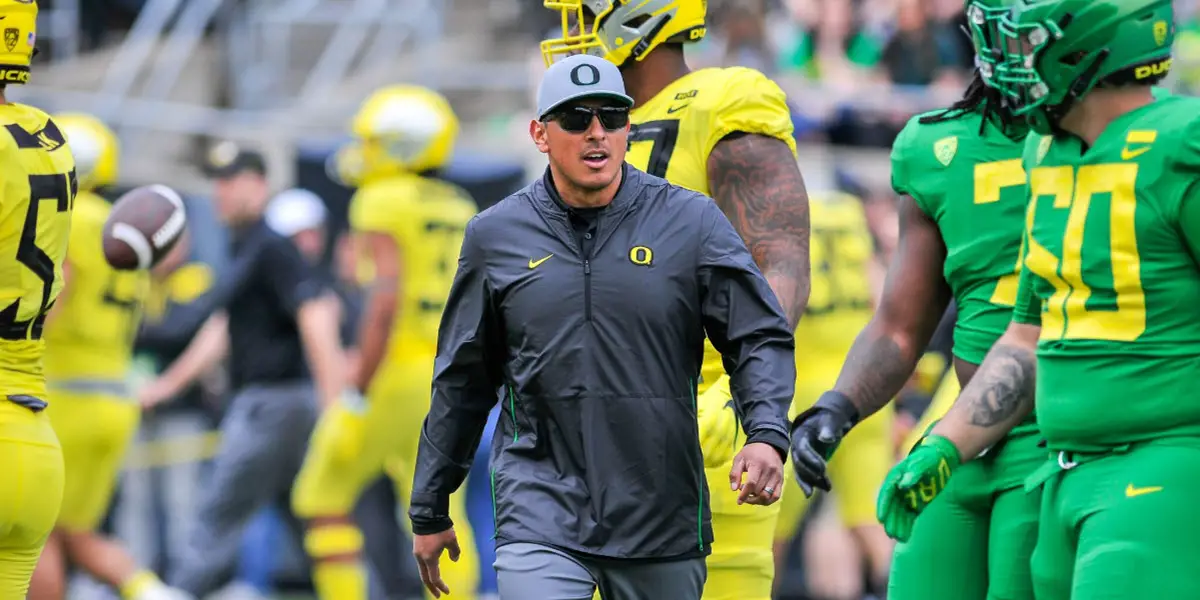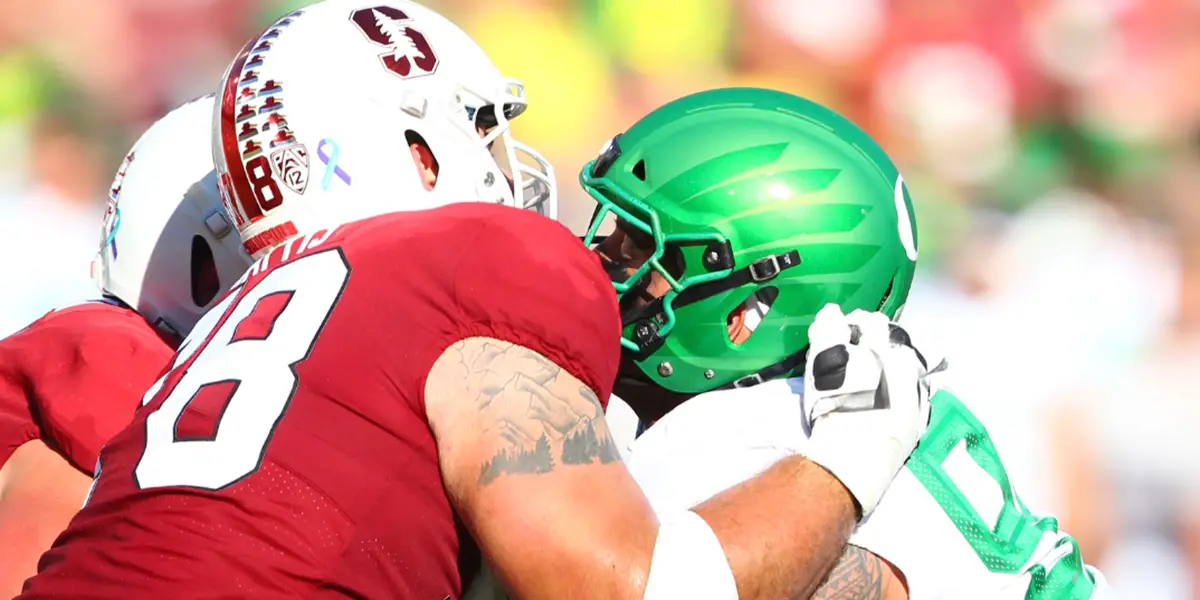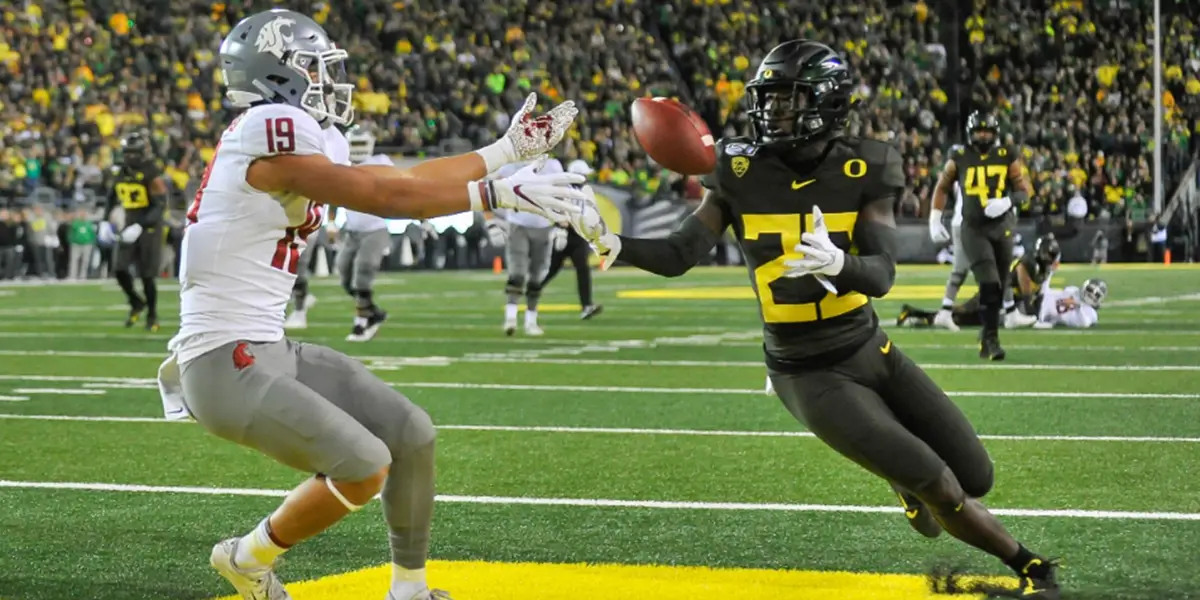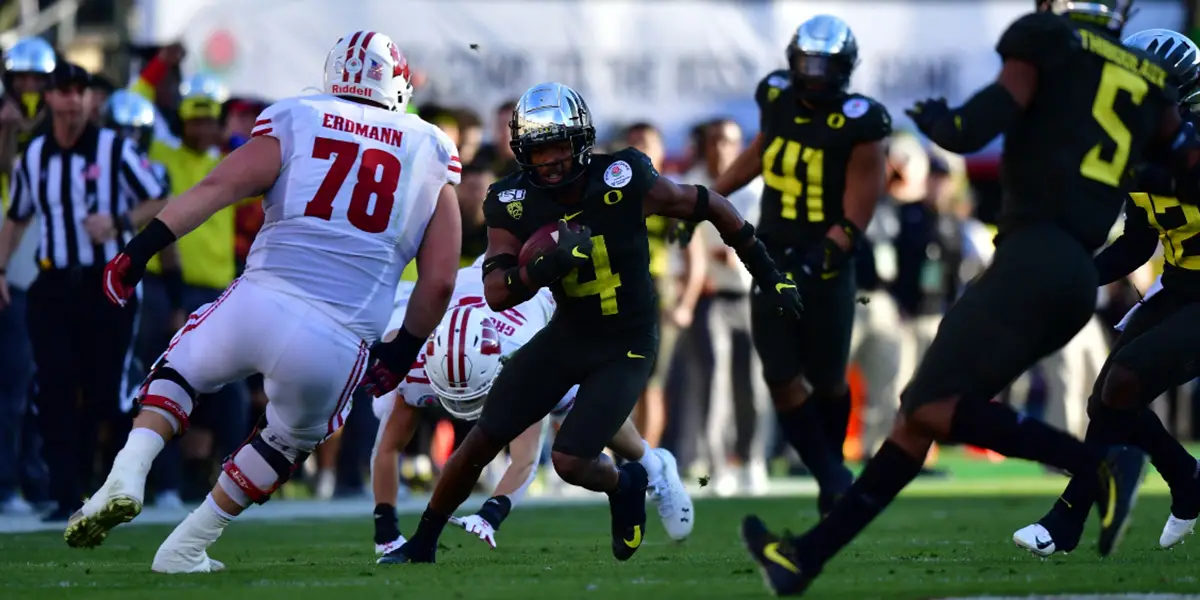Spring football — and the sports world as a whole — is understandably at a standstill at the moment. But luckily for all of the sports-deprived Oregon fans, there’s still plenty to digest from the Ducks’ initial spring practices.
One of the most interesting takeaways was that stalwart cornerback Thomas Graham Jr. worked out at the nickelback position and spent time with safeties coach Keith Heyward during Oregon’s first practice. The temporary position switch may not have stolen national headlines, but it’s noteworthy because it illustrates just what makes Andy Avalos’ defense so hard for opposing offenses to gameplan for.
With offenses becoming more varied by the minute, the best defenses need to be formless and adaptable, adjusting week by week, capable of handling a number of offensive schemes and personnel groupings. That’s exactly the type of defense that Avalos is building at Oregon. Giving Graham experience at safety, while inserting the very talented Mykael Wright in his place at cornerback, gives the Ducks’ defense a new look for offenses to prepare for and it makes the defense even more versatile.
No Two Offenses Are the Same
Life is hard as a defensive coordinator in college football. Not only are offensive playmakers getting bigger, stronger and faster by the season, but there’s so much schematic variance between offenses that it’s extremely difficult to stick to a base defensive philosophy or formula and be successful.

Defensive coordinators like Andy Avalos face a tremendous challenge in modern-day college football.
In an interview with 247Sports, Mario Cristobal summed up the challenge that the Ducks’ defense faces:
“We want to maximize the opportunity to play all of the multiple-personnel groupings we face throughout the course of the season. In our conference, you have air raid teams, 21-personnel teams. You have some new coaches who are going to bring in some new systems. You want to be prepared to be multiple [defensively].”
Avalos is tasked with slowing down pass-heavy teams like Washington State (which will likely still air it out under new head coach Nick Rolovich), while also stopping old-school, traditional offenses like Stanford and its bludgeoning rushing attack. Even the most talented defenses would struggle to match up against such a drastic contrast of offensive styles by sticking with the same personnel groupings and base defensive system. A great defense in modern-day football has to be fluid.

Stanford’s mauling offense is one of the many different systems that Oregon will face in 2020.
That’s exactly why Oregon’s defense improved so significantly under Avalos. His defensive system’s calling card is its unpredictability and adaptability.
For example, in the Rose Bowl against Wisconsin, the Ducks knew that they had to contain 2,000-yard rusher Jonathan Taylor and the ever-imposing Badger offensive line. If the Badgers controlled the line of scrimmage, they would control the clock and effectively the game — a strategy that has doomed the Ducks in prior years. So Avalos and company loaded the box and employed their best run defenders to stop Taylor in his tracks. Linebacker Isaac Slade-Matautia, a 231-lb. thumper, and safety Brady Breeze, a physical, tone-setting defensive back, were asked to carry the defense because of their run-clogging skills, even though neither of them had been overly impressive up to that point.
The strategy paid off, as Oregon held Taylor to less than 100 yards despite his 21 carries. And unsung heroes Slade-Matautia and Breeze led the charge, each finishing with a season-high in total tackles.
Rewind to earlier in the season when Oregon faced Washington State’s air raid offense, and the strategy was entirely different but still largely successful. A matchup in which controlling the line of scrimmage was irrelevant, the Ducks relied on their secondary to force turnovers and stop the efficient Cougar offense in critical situations. And though Washington State put up over 400 passing yards and scored over 30 points, the Ducks accomplished their goal defensively by forcing two critical turnovers — one of which thwarted a scoring drive, while the other was a pick-six.

The Ducks’ secondary made plays at critical times against Washington State.
Oregon’s defensive gameplan in these two cases had to be polar opposites because of the contrasting offensive styles that it faced, and that’s generally problematic for a defensive coordinator. No coach wants to alter his scheme entirely during the season, so typically, he’ll adjust it as best as he can within the structure of his system. Luckily, that flexibility is what Avalos’ entire system is based off of, so drawing up and executing vastly different gameplans isn’t an issue for the Ducks.
There’s More in Store for 2020
Graham’s switch to safety — even if it is just a temporary experiment — shows that the Ducks will unveil even more varied defensive looks and personnel groupings in 2020. With so many talented players on defense, specifically in a loaded secondary, it’s great to see the coaching staff looking for ways to get more defensive playmakers on the field at the same time.
Wright, the third cornerback in the rotation in 2019, returns as one of the best cornerbacks in the country, and he likely won’t even be a starter based on traditional personnel groupings. But with Graham even occasionally playing as the nickelback, Wright can get more opportunities to make an impact without sacrificing Graham, who is also a top-tier cornerback.
It’s subtle changes like this that make Oregon’s defensive system so difficult for opposing offenses to prepare for. It’s early, but if the start of spring practice is any indication, expect another year of a predictably unpredictable defense from Avalos and the Ducks.
Joshua Whitted
Morgantown, West VirginiaTop Photo by Tom Corno
Joshua is an adopted Duck fanatic, originally hailing from southwestern Pennsylvania. His love for the University of Oregon began as a young child when he became mesmerized by the flashy uniforms and explosive offenses of the Chip Kelly era, and now, he follows the team religiously. His fondest memory of the team is seeing De’Anthony Thomas race past Wisconsin defenders back in the 2012 Rose Bowl. A true football enthusiast, Joshua loves studying the intricacies of the game, and he aspires to become a professional sports journalist. Joshua now resides in Morgantown, West Virginia where he works in customer service. When he’s not watching Oregon replays, Joshua loves reading, writing, and spending time with his family. Contact: whittedjd@gmail.com


